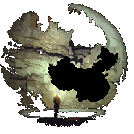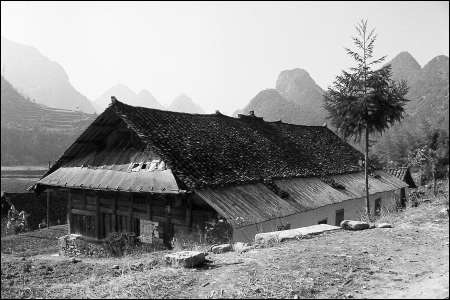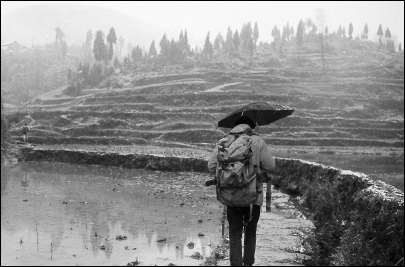
Grottes et karsts de Chine
Sur les traces de Xu Xiake
The expedition
Résumé - Abstract - Zusammenfassung : In the course of the three expeditions Guizhou 86, Gebihe 89 and Donghe 92 altogether more than 150 caves with a total of 161 km of mapped passage length were visited in 12 counties of the provinces Guizhou, Sichuan, Hubei and Hunan provinces. The success resulted from a veritable cultural exchange between Chinese and European scientists and cavers in addition to an understanding of mutual confidence and devoted friendship.
 In each of the areas visited, remarkable caves were investigated. In Guizhou, for example, the fabulous underground river Gebihe was found in Ziyun county to hold up to 150 m high galleries, giant pits of 210 and 370 m depths and the world's second largest underground room, the Miao Chamber which is measuring 700 by 215 by 70 m in length, width and height. In Zhijin county, the syncline of Santang covers an area of 150 square kilometres and holds 14 mapped caves, the largest of which is the 7.2 km long Santangdongqun. Additionally the semi-subterranean course of the river Yijiehe was explored, which consists of a series of natural bridges, collapse dolines and gorges associated with the cave Daxiaocaokou (2.929 m/?235 m). In Luodian county, two underground rivers joining at the bottom of a giant doline were explored (on the map only!). In Hubei province, in the Changleping anticline, 40 kilometres of cave were mapped, e.g. Donghe (4.828 m/?270 m), Longdong-Yanzidong (5.692 m/+147 m), the sinkhole Dadong (10.932 m/±314 m) and the alpine caves Dongxitiankeng (5.807 m/?382 m) and Tiankengcao (?230 m). In Wuxi county of Sichuan province, the alpine aspect of karst was investigated in a geological situation of folded structures with deep canyons like the Daninghe. which offers a depth potential of 1.600 m (explored to ?150 m) in the eastern Wuxi syncline.
In each of the areas visited, remarkable caves were investigated. In Guizhou, for example, the fabulous underground river Gebihe was found in Ziyun county to hold up to 150 m high galleries, giant pits of 210 and 370 m depths and the world's second largest underground room, the Miao Chamber which is measuring 700 by 215 by 70 m in length, width and height. In Zhijin county, the syncline of Santang covers an area of 150 square kilometres and holds 14 mapped caves, the largest of which is the 7.2 km long Santangdongqun. Additionally the semi-subterranean course of the river Yijiehe was explored, which consists of a series of natural bridges, collapse dolines and gorges associated with the cave Daxiaocaokou (2.929 m/?235 m). In Luodian county, two underground rivers joining at the bottom of a giant doline were explored (on the map only!). In Hubei province, in the Changleping anticline, 40 kilometres of cave were mapped, e.g. Donghe (4.828 m/?270 m), Longdong-Yanzidong (5.692 m/+147 m), the sinkhole Dadong (10.932 m/±314 m) and the alpine caves Dongxitiankeng (5.807 m/?382 m) and Tiankengcao (?230 m). In Wuxi county of Sichuan province, the alpine aspect of karst was investigated in a geological situation of folded structures with deep canyons like the Daninghe. which offers a depth potential of 1.600 m (explored to ?150 m) in the eastern Wuxi syncline.
 As a whole the expeditions happened in a warm atmosphere despite of the rather glacial hotel room temperatures. Out of six days five were spent somewhat struggling with time to cope with time-tables imposed by drivers and cooks, for the Chinese gastronomy is both refined and varied. The medical infrastructure is modest but there are dispensaries found every once in a while. Since the Chinese country side is densely populated, most of the water is polluted, and it is a must to boil all drinking water, as it is systematically done by the Chinese themselves. The apparently unavoidable sicknesses caught by the expedition members were colds, coughs, stiff necks, and the like.
As a whole the expeditions happened in a warm atmosphere despite of the rather glacial hotel room temperatures. Out of six days five were spent somewhat struggling with time to cope with time-tables imposed by drivers and cooks, for the Chinese gastronomy is both refined and varied. The medical infrastructure is modest but there are dispensaries found every once in a while. Since the Chinese country side is densely populated, most of the water is polluted, and it is a must to boil all drinking water, as it is systematically done by the Chinese themselves. The apparently unavoidable sicknesses caught by the expedition members were colds, coughs, stiff necks, and the like.
Speleological researches by Westerners have substantially increased since 1985, and subsequently dozens of spacious cave kilometres have been explored and mapped to result in knowledge on longer and deeper cave systems. In this connection one should remind of the underground studies undertaken by the Chinese colleagues, which already started 400 years ago by the untiring geographer and cave explorer Xu Xiake.
Finally a registry is given which lists the largest pits and subterranean chambers in addition to the longest and deepest caves of China. Some of the data given, however, need confirmation. To our knowledge, altogether 68 caves longer than 2 km were explored at the end of 1994. Nevertheless, only a small part of the immense Chinese cave potential is considered.